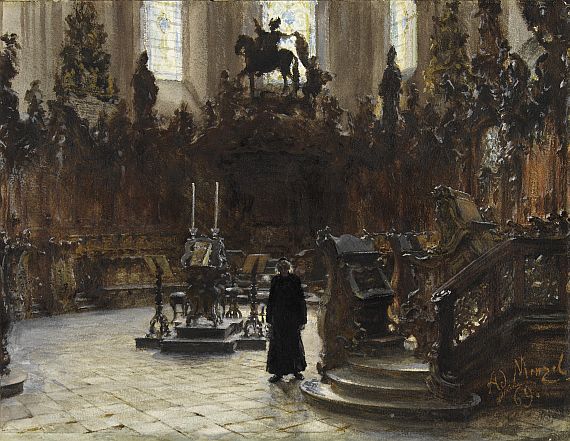Dictionary


Russian Realism
Russia was decisively affected by the realist idea in the second half of the 19th century. Not only in painting, also in literature and in music were artists searching for a realistic, social and critical depiction of everyday life.
The early period of Russian Realism, from the 1850s to the 1870s, shows its basically revolutionary characteristic: The "Revolt of Fourteen" at the St. Petersburg academy, in which students were asking for a free choice of topics and refused to accept historical subjects, is exemplary thereof.
A famous subject of Russian Realism was the peasant. The subject, also often used by Western European realists, was of a particular controversial explosiveness, due to the then social situation in 19th century Russia: Serfdom was still in effect up until 1861, which had a dramatic effect on the peasants' situation. Artists began to examine this issue, thus Russian Realism was characterized by a socially critical attitude. The influential Russian Federation of Touring Exhibitions, also called "Wanderer" (Peredvizhniki) was founded in 1870, making sure that the new style would be spread all over the country.
The orientation with France was also decisive for the development of Realism in Russia. Instead of seeking an artistic revelation, as it was the case in Italy, a Russian artists ‚ colony now arose in France around the landscape painter Aleksei Bogolyubov (1824-96) and his "Russian Artists' Association".
Despite this French influence of Russian Realism, Impressionism was only taken on restrainedly by the second generation of Russian realists, and that was less as an inner principle than an artistic enrichment of socially critical Realism, which had consolidated in Russia and was only slowly pushed aside by Symbolism.
The indisputable main representative of Russian Realism is Ilya Repin (1844-1930) with his epic works with many figures. He was accompanied by Konstantin Savitsky and Vasily Surikov, as well as Valentin Serov, Isaac Levitan, Abram Arkhipov and numerous other artists of the second generation.
Russia was decisively affected by the realist idea in the second half of the 19th century. Not only in painting, also in literature and in music were artists searching for a realistic, social and critical depiction of everyday life.
The early period of Russian Realism, from the 1850s to the 1870s, shows its basically revolutionary characteristic: The "Revolt of Fourteen" at the St. Petersburg academy, in which students were asking for a free choice of topics and refused to accept historical subjects, is exemplary thereof.
A famous subject of Russian Realism was the peasant. The subject, also often used by Western European realists, was of a particular controversial explosiveness, due to the then social situation in 19th century Russia: Serfdom was still in effect up until 1861, which had a dramatic effect on the peasants' situation. Artists began to examine this issue, thus Russian Realism was characterized by a socially critical attitude. The influential Russian Federation of Touring Exhibitions, also called "Wanderer" (Peredvizhniki) was founded in 1870, making sure that the new style would be spread all over the country.
The orientation with France was also decisive for the development of Realism in Russia. Instead of seeking an artistic revelation, as it was the case in Italy, a Russian artists ‚ colony now arose in France around the landscape painter Aleksei Bogolyubov (1824-96) and his "Russian Artists' Association".
Despite this French influence of Russian Realism, Impressionism was only taken on restrainedly by the second generation of Russian realists, and that was less as an inner principle than an artistic enrichment of socially critical Realism, which had consolidated in Russia and was only slowly pushed aside by Symbolism.
The indisputable main representative of Russian Realism is Ilya Repin (1844-1930) with his epic works with many figures. He was accompanied by Konstantin Savitsky and Vasily Surikov, as well as Valentin Serov, Isaac Levitan, Abram Arkhipov and numerous other artists of the second generation.
Offers
Headquarters
Joseph-Wild-Str. 18
81829 Munich
Phone: +49 89 55 244-0
Fax: +49 89 55 244-177
info@kettererkunst.de
Louisa von Saucken / Undine Schleifer
Holstenwall 5
20355 Hamburg
Phone: +49 40 37 49 61-0
Fax: +49 40 37 49 61-66
infohamburg@kettererkunst.de
Dr. Simone Wiechers / Nane Schlage
Fasanenstr. 70
10719 Berlin
Phone: +49 30 88 67 53-63
Fax: +49 30 88 67 56-43
infoberlin@kettererkunst.de
Cordula Lichtenberg
Gertrudenstraße 24-28
50667 Cologne
Phone: +49 221 510 908-15
infokoeln@kettererkunst.de
Hessen
Rhineland-Palatinate
Miriam Heß
Phone: +49 62 21 58 80-038
Fax: +49 62 21 58 80-595
infoheidelberg@kettererkunst.de
We will inform you in time.




